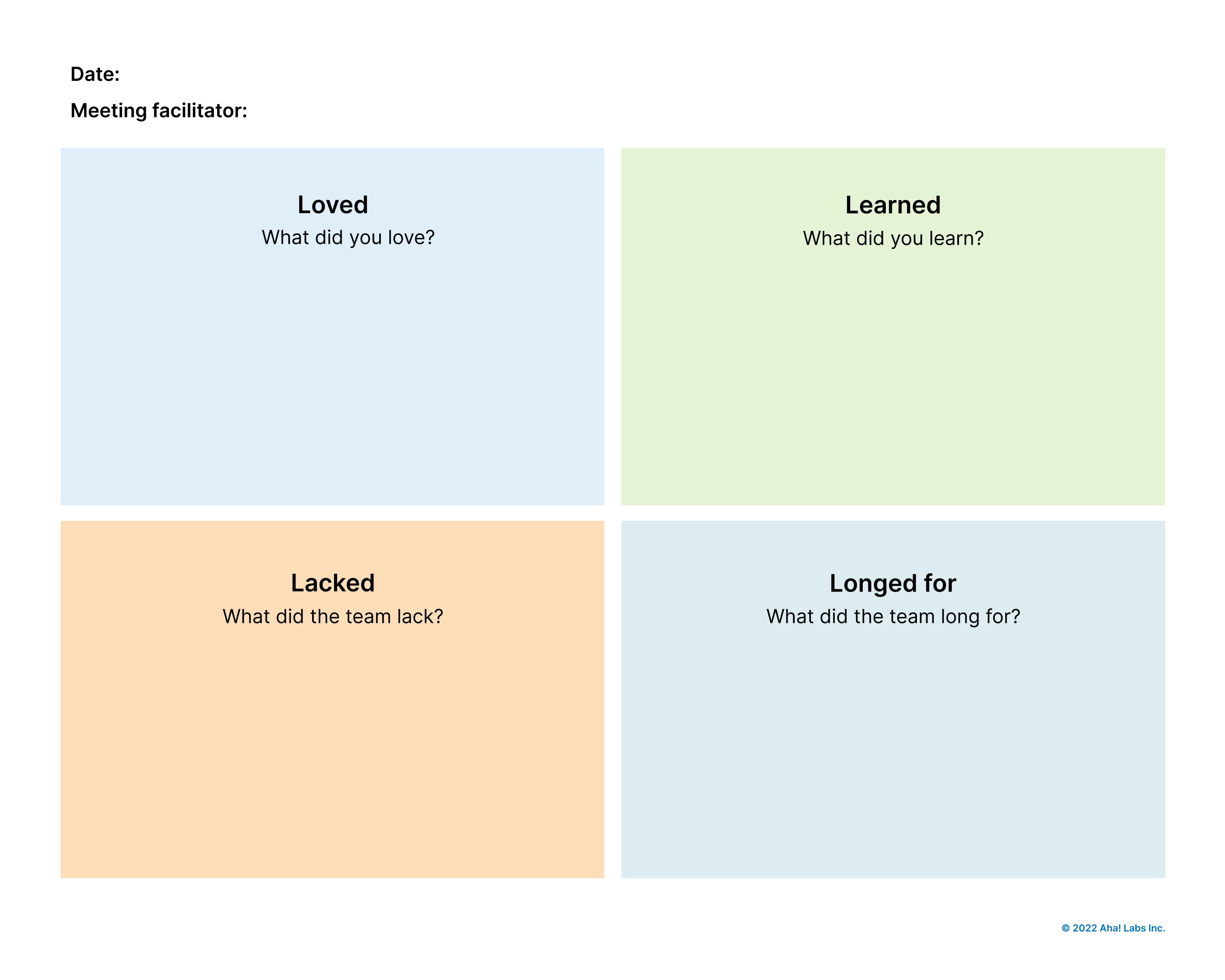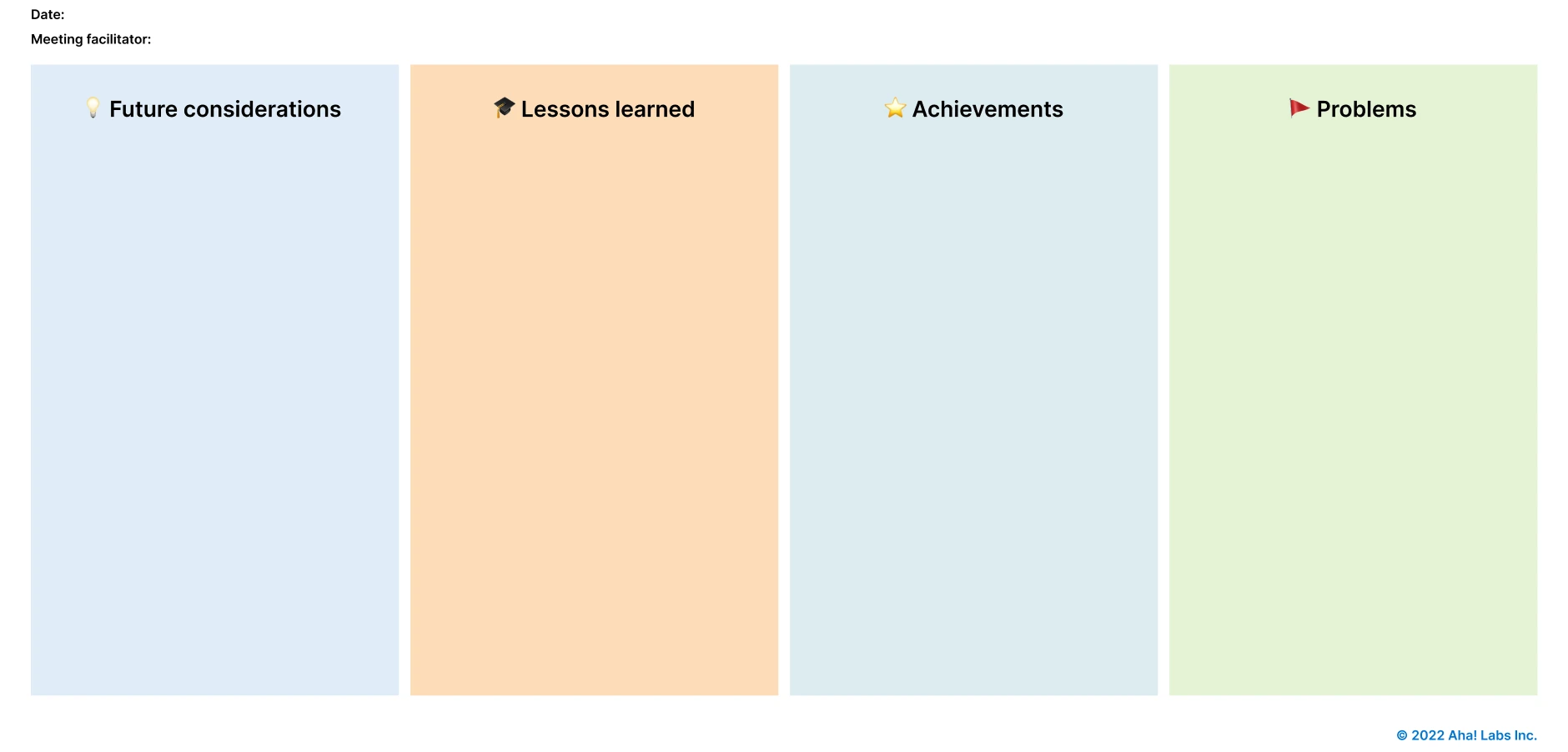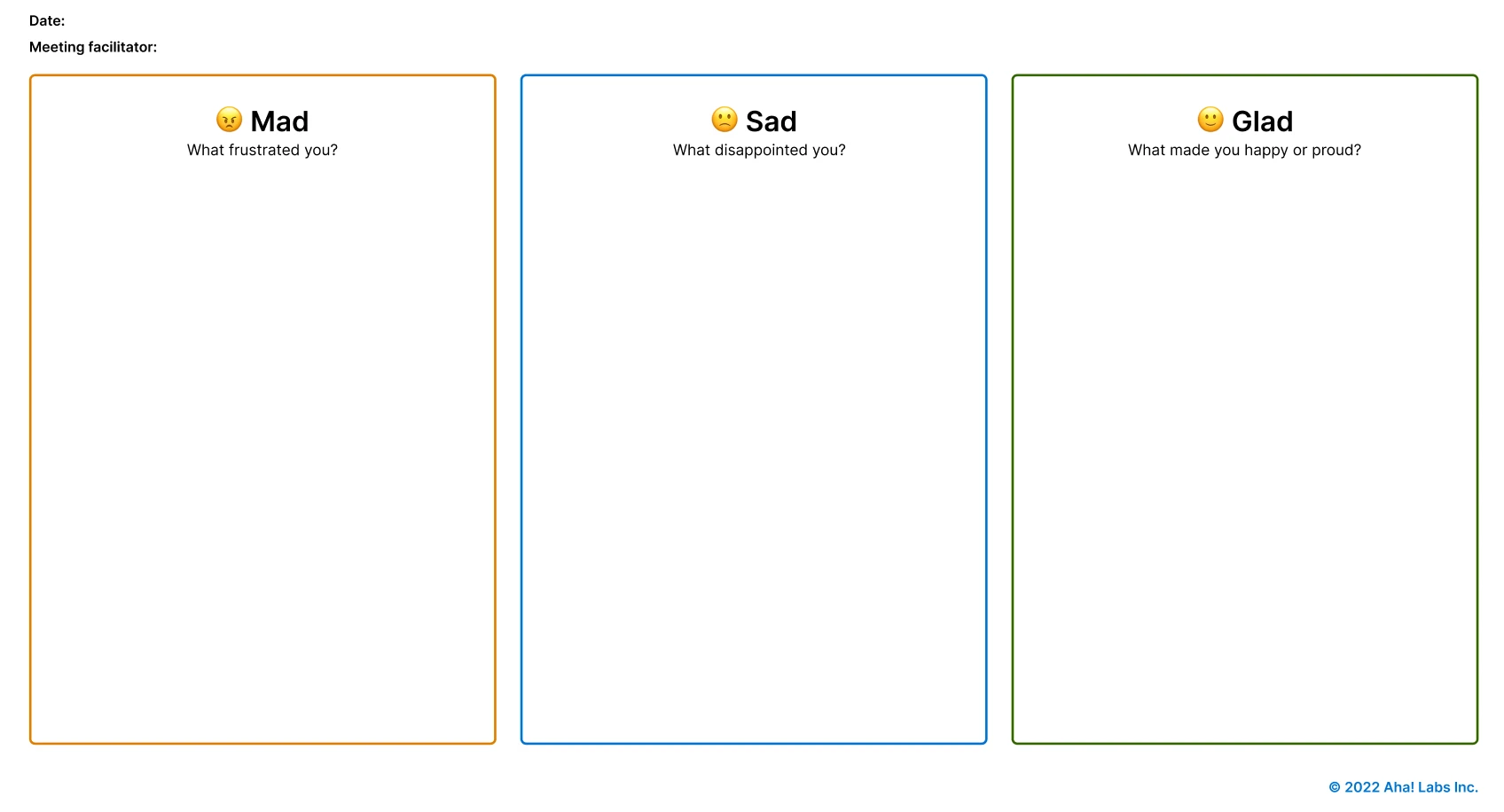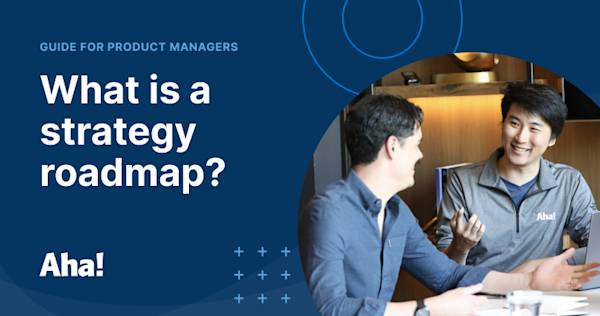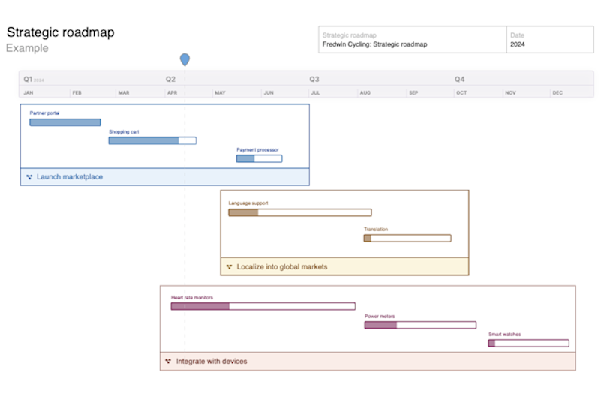12 sprint retrospective templates for product teams
Last updated: March 2024
Sailboat. Hot air balloon. Mountain climbing. Are you picturing adventurous excursions? Possibly. But if you are part of an agile team, you might be familiar with these terms as techniques for retrospective discussions. Using memorable frameworks like these can help to shape your retrospectives, so it is easier to glean insights into your goals, obstacles, and achievements — and improve future sprints.
Sprint retrospectives are most popular among scrum teams, but any agile team can hold retrospective meetings to reflect on other types of work — like recent releases or key projects. To encourage open and fruitful discussions, many teams rely on creative frameworks guided by visual tools or templates.
In this guide, you can access retrospective templates to help freshen and direct your discussions. If you want to get started right away, try the built-in sprint retrospective template in Aha! software.
If you use Aha! Develop to manage engineering work, you can also make use of team whiteboards and notes within your account. This guide also includes downloadable sprint retrospective templates if you would prefer to get started that way.
Try the sprint retrospective template in Aha! software. Sign up for a free trial.
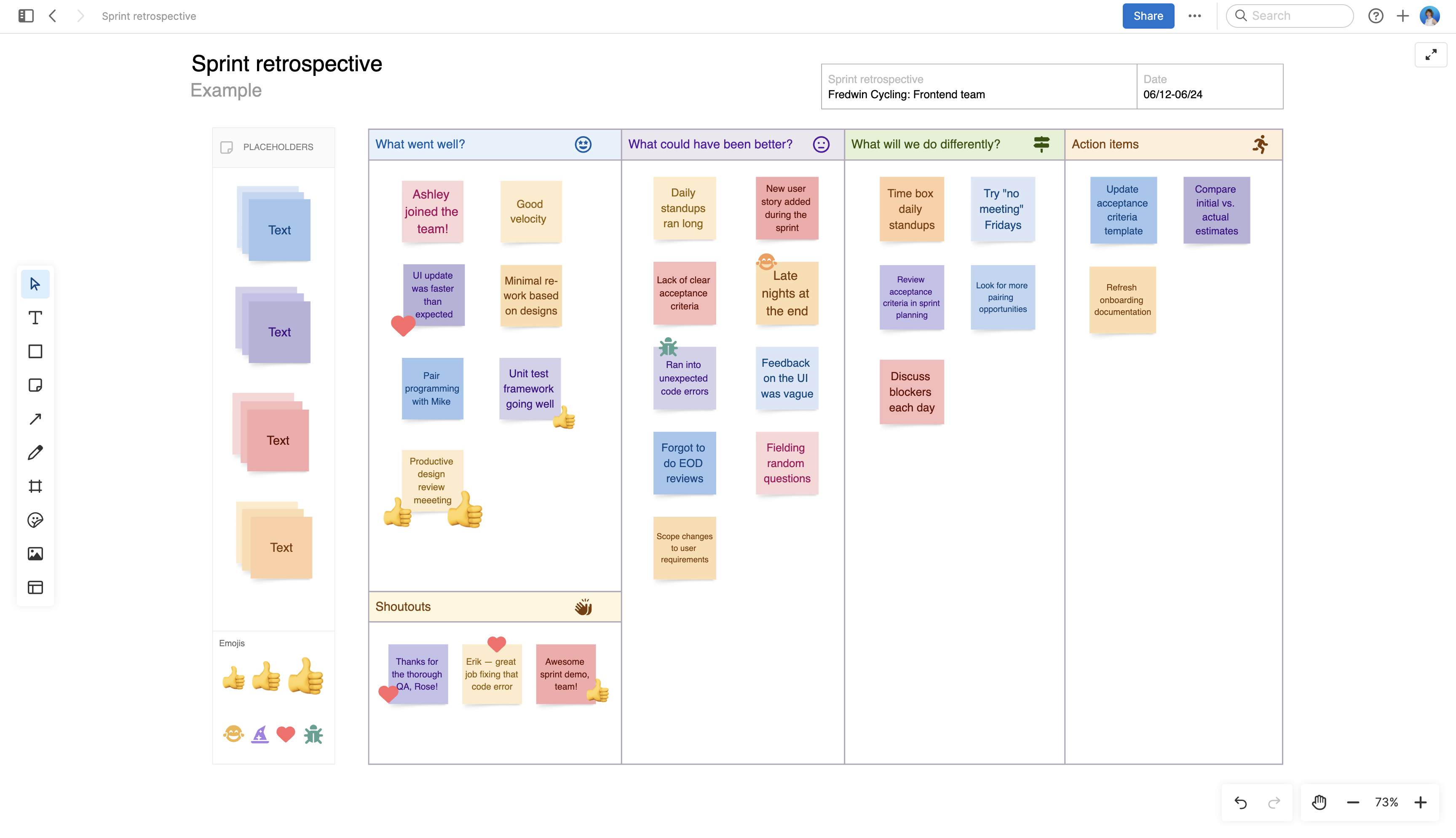
Jump ahead to the guide sections that are most useful for you:
What is a sprint retrospective?
Sprint retrospectives are held after a sprint concludes — usually immediately after the sprint review. During the retrospective, agile development teams discuss what went well, what did not go well, and what you can do to make the next sprint even better. This practice is essential to the agile philosophy of continuous improvement. Overall, the emphasis should be on what you have learned and how you can apply those lessons to the next sprint.
Retrospective meetings are a dedicated time to dig into current processes and tools. It is a space to share triumphs as well as areas of concern. And the conversation should lead to an understanding of why the team ran into obstacles and how efforts led to success — talking about underlying causes can help you repeat or avoid similar outcomes in the future.
Everyone should walk away from retrospective discussions with a tangible list of action items to implement in the next sprint. These should be easily achievable tasks that help you either reinforce positive results or reduce negative ones.
Related:
Why do I need a sprint retrospective template?
Sprint retrospectives meetings are a blend of a discussion forum and a working session. Conversation frameworks can support both meeting purposes — bolstering connection and productivity at the same time.
Over the years, scrum masters have devised a number of these frameworks to help guide sprint retrospective discussions — often in the form of diagrams, images, and interactive exercises. Since these techniques have become so popular and effective, agile teams use templatized versions in their discussions.
Before we take a closer look at the templates, here are the main ways your team can benefit from a sprint retrospective template:
Freshness: Retrospectives can get stale over time. A variety of templates helps meetings stay fresh and productive. With so many templates to choose from, even seasoned teams can usually find a new one to try.
Openness: Sprint retrospective templates provide a low-pressure way to share authentic feelings — via conversation starters, visuals, and specific questions (e.g. "what is one thing we should stop doing?") versus open-ended ones (e.g. "how do you think the sprint went?").
Fairness: Templates encourage full participation. Each teammate spends a few minutes reflecting, sometimes writing ideas on physical or digital sticky notes, and then discussing their thoughts. Taking turns ensures each person's voice is heard — even if they are not the loudest.
Direction: Scrum teams collectively own their wins and losses. When discussing poor results, retrospective templates provide guiding prompts that direct discussions on the overall sprint process and avoid scapegoating.
Efficiency: A retrospective template keeps the conversation moving. Think of it like a basic agenda — outlining your talking points and previewing the order of events. For scrum teams, this is especially helpful as sprint retrospectives are timeboxed.
Knowledge sharing: Collective insights are valuable. Capturing everything in a template lets you revisit learnings later to evaluate how things have improved.
Get started with sprint retrospective templates
During a sprint retrospective, your meeting agenda is simple: introduce the template you will be using, gather input on the last sprint (both positive and negative takeaways), brainstorm ideas for the next one, and choose your action items. Each of the retrospective templates below will help you kickstart engaging conversations — then collect, organize, and act on insights.
Whiteboard sprint retrospective template
This template gives the ability to host a collaborative sprint retrospective on a virtual whiteboard. Document what went well, what could have gone better, and what you would do differently next time. Then, identify and assign action items for the team.

4 Ls sprint retrospective template
The four "L's" stand for loved, learned, lacked, and longed for. The 4Ls retrospective template offers a clear structure for examining the positives and negatives of that sprint — both technical and team-related. You might also call this one the "Lessons Learned" exercise.
To use the 4 Ls retrospective template, team members write their takeaways for each "L" and place them in the corresponding box.
Agile sprint retrospective notes template
This simple retrospective template will help you structure your notes, document action items, and run a productive meeting. This is an effective starter template for any agile team regardless of which methodology you follow.
This template is best suited for use by the meeting facilitator or a designated scribe that can take notes for the whole team.
DAKI sprint retrospective template
The DAKI retrospective template is a two-by-two grid. "DAKI" is an acronym for the different discussion items: drop, add, keep, and improve. Briefly, these mean:
Drop: What should we remove from our process in the next sprint?
Add: What should we add to our process?
Keep: What we should continue doing?
Improve: Which areas need improvement?
Try this template for a quick and streamlined discussion. Have team members write and share thoughts as sticky notes or comments in each quadrant.
DAKI sprint retrospective template
The DAKI retrospective template is a two-by-two grid. "DAKI" is an acronym for the different discussion items: drop, add, keep, and improve. Briefly, these mean:
Drop: What should we remove from our process in the next sprint?
Add: What should we add to our process?
Keep: What we should continue doing?
Improve: Which areas need improvement?
Try this template for a quick and streamlined discussion. Have team members write and share thoughts as sticky notes or comments in each quadrant.
FLAP sprint retrospective template
Another easy acronym to work with is FLAP, which stands for:
Future considerations: Based on what we have learned, what should we consider for the next sprint?
Lessons learned: What are our top takeaways from the last sprint?
Accomplishments: What were the high points of the last sprint?
Problems: What were the low points of the last sprint?
The FLAP template is helpful for discussing both the prior sprint and ideas for upcoming work periods. Similar to the 4L's and DAKI templates, team members take turns sharing their ideas for each component of the FLAP template.
Hot Air Balloon sprint retrospective template
For a more creative approach, try a Hot Air Balloon retrospective template. This template uses a fun visual metaphor to spur discussions around your key takeaways and ideas for improvement. Use this template to talk about your:
Hot air: What lifted the team up during the last sprint?
Sandbags: What dragged the team down?
Sunny skies: Which points of the sprint felt positive or easy?
Stormy weather: Which points of the sprint felt challenging or risky?
Mad, Sad, Glad sprint retrospective template
Mad, Sad, Glad retrospective templates prompt team members to reflect on the past sprint in a more emotional way. Asking everyone to think about what made them feel frustrated, disappointed, or happy can help uncover more personal takeaways.
Mountain Climber sprint retrospective template
The Mountain Climber retrospective template is another visually engaging technique. In this template, you will discuss how different elements affected your ability to reach your sprint goals, represented by:
Boulders: What obstacles did we face during the last sprint?
Climbing equipment: What helped us on the climb towards our goal?
Inclement weather: What posed a delay, setback, or disruption?
The summit: Did we reach our sprint goal?
Rose, Thorn, Bud sprint retrospective template
In this exercise, a rose represents highlights and successes, thorns describe challenges or pain points, and buds represent new ideas for growth and improvement. Use the Rose, Thorn, Bud retrospective template for a thoughtful conversation starter with straightforward talking points.
Sailboat sprint retrospective template
Similar to Hot Air Balloon and Mountain Climber, the Sailboat retrospective template is a visual depiction of how your current workflows are faring. (The simplified version of this is called an "Anchors and Engines" retrospective template.) Use the Sailboat template to evaluate your:
Wind: What pushed us forward during the last sprint?
Anchors: What held us back?
Rocks: What obstacles or risks did we face?
Land: Did we reach our sprint goal?
Starfish sprint retrospective template
The Starfish retrospective template is future-focused. Rather than recounting the past, it centers the discussion on how the previous sprint will shape the sprints ahead. Use this five-pronged diagram to define:
What to do more of
What to do less of
What you will keep doing
What you will stop doing
What you will start doing
Start, Stop, Continue sprint retrospective template
The Start, Stop, Continue retrospective template offers a balanced way to examine positives and negatives. Similar to the Starfish retrospective template, it encourages your team to consider how to reinforce positive outcomes. Remember, not every idea for improvement needs to be brand new for each sprint.
In this template (and others), you may find it helpful to use icons or color-coding to indicate categories (e.g. process, tool, and team).
Start, Stop, Continue sprint retrospective template
The Start, Stop, Continue retrospective template offers a balanced way to examine positives and negatives. Similar to the Starfish retrospective template, it encourages your team to consider how to reinforce positive outcomes. Remember, not every idea for improvement needs to be brand new for each sprint.
In this template (and others), you may find it helpful to use icons or color-coding to indicate categories (e.g. process, tool, and team).
With sprint retrospective templates handy, you will always have fresh inspiration for thoughtful discussions. Try downloading one of these templates for your next meeting — or use the sprint retrospective template for free in Aha! software to take notes, build a whiteboard, and spark conversation in a new way.
Plus, incorporate the learnings from your retrospectives in your next sprint right within the same software suite. Aha! Develop is the ideal place to plan and track sprints and deliver any kind of engineering work — so your team can achieve even more.
Streamline your agile development process with Aha! Develop. Start a free trial today.
FAQs about sprint retrospectives
A sprint retrospective is conducted at the end of each sprint, after the sprint review and before the next sprint planning session. This timing allows the team to reflect on its completed work and identify improvements for the upcoming sprint. (If you want to learn more about sprints, you can do so here!)
The primary purpose of a sprint retrospective is to reflect on the team's recent work and identify actionable ways to improve. By discussing what went well, what did not, and how to enhance processes, the team fosters continuous improvement and collaboration.
To conduct an effective sprint retrospective:
Set the stage: Create an open environment where team members feel comfortable sharing honest feedback.
Gather data: Discuss what occurred during the sprint, focusing on successes and challenges.
Generate insights: Analyze the data to identify patterns and root causes.
Decide on action items: Agree on specific steps to improve processes in the next sprint.
Close the meeting: Summarize key takeaways and express appreciation for the team's contributions.
There are all kinds of structured formats to help you facilitate a sprint retrospective (think hot air balloon, mountain climber, or sailboat). But if you are looking for a naturally collaborative session on a virtual whiteboard, check out our dedicated sprint retrospective template.
